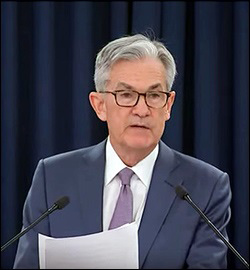By Pam Martens and Russ Martens: July 20, 2020 ~
Quietly, on July 13, the New York Fed published a list of asset-backed loans that it had approved for eligibility in one of its emergency lending programs, the Term Asset-Backed Securities Loan Facility, otherwise known as TALF.
The New York Fed stuck a smattering of small business loans and one student loan product on the list. Everything else was securitized pools of mortgages on commercial real estate, much of it issued by JPMorgan and Citigroup. TALF was supposed to help the consumer by keeping interest rates down on consumer loans. It’s pretty tough to find a connection between the consumer and commercial real estate mortgages on hotels, shopping malls and office buildings.
One thing notable about the New York Fed’s approved list is that the securitizations of these commercial mortgages by JPMorgan had occurred as far back as 2013 and in the case of Citigroup, as far back as 2015. Is it really the job of the Fed to bail out the banks from old deals that are now souring?
You may be wondering if the commercial real estate mortgages had already been securitized and sold off to investors, how does this constitute a bailout of the banks by the Fed. It’s because the market value of those deals had been dramatically sagging until the Fed set up its bailout program, thus boosting the market value of those deals as well as similar mortgages still on the books of the banks.
The purpose of TALF, according to the Fed, is to “help meet the credit needs of consumers and businesses by facilitating the issuance of asset-backed securities.” Note the word “issuance” in this sentence. Bailing out old deals that have already been issued does nothing to help new issuance, unless one considers the Fed distorting the market to be a help.
The New York Fed’s list was published on July 13. But the Fed had waved in some of these deals as early as June 25 because that’s when it made a raft of loans under TALF.
According to its newly released transaction data for TALF, it has made a total of $252 million in loans thus far – the vast majority of which involved commercial real estate loans issued by the biggest Wall Street banks at some point over the past seven years. (To check out the transaction data, scroll down here to Term Asset-Backed Securities Loan Facility, click on the transaction data and use the tabs at the bottom of the spreadsheet.)
The key borrower, who has been given Fed loans under TALF thus far of $88 million, is an investment firm out of Mission Woods, Kansas called Palmer Square Capital. It has purchased four securitized commercial real estate mortgage deals issued by JPMorgan; three issued by Citigroup; two issued by GS Mortgage Securities (a company that includes issuance by Goldman Sachs); one by UBS and one by Wells Fargo.
A married couple, Chris and Angie Long, are the top two executives at Palmer Square Capital. Chris is Chairman, CEO and Portfolio Manager. Angie Long is Chief Investment Officer. Before Ms. Long arrived at Palmer Square in 2011, she had worked for JPMorgan in New York for the prior 13 years, including the following senior roles: Deputy Head of North American Credit Trading, Head of High Yield Trading, and Head of Credit Derivatives Trading.
The U.S. Treasury Department has put up $10 billion of taxpayers’ money to eat losses on TALF loans in the same way that the Treasury Department has committed $75 billion of taxpayers’ money to eat losses on the Fed’s corporate bond buying programs, which include the purchase of bonds downgraded to a junk rating after March 22.
The TALF loans are nonrecourse – meaning that all that Palmer Square Capital has to lose is the collateral it puts up, consisting of the commercial mortgage loans in each of the deals and the 1.3 percent interest it is paying the Fed on the loan.
Unfortunately, the TALF loans are currently set to mature on June 26, 2023 – which means that one would need an outlook that shows the U.S. recovering from the worst economic disaster since the Great Depression in a period of three years. The Longs, however, may believe that the Fed will simply extend the loans on the maturity date.
Another large borrower in TALF is none other than BlackRock, the same firm that is serving as the investment manager for the Fed’s corporate bond buying program. BlackRock has borrowed $82.7 million under TALF. It has used the money to buy four commercial real estate mortgage deals, two from UBS, one from Barclay’s and one from CSAIL (Credit Suisse). Included in the $82.7 million are also two loans involving pooled Small Business Administration loans.
This is a reincarnation of the original TALF by the Fed, and thus is known as TALF II on the Fed’s balance sheet. TALF I was one of the alphabet soup of emergency lending facilities that the New York Fed created to bail out the Wall Street banks during the financial crisis of 2007 to 2010.


